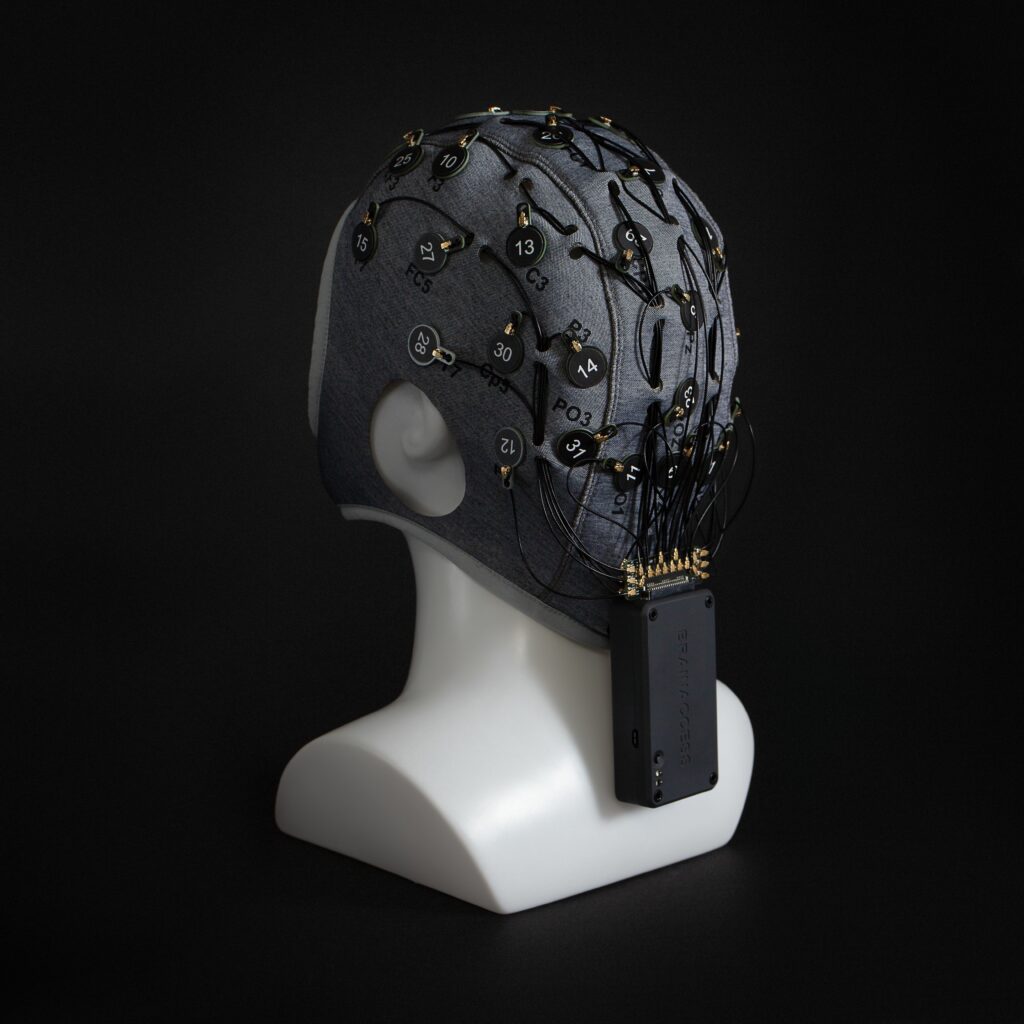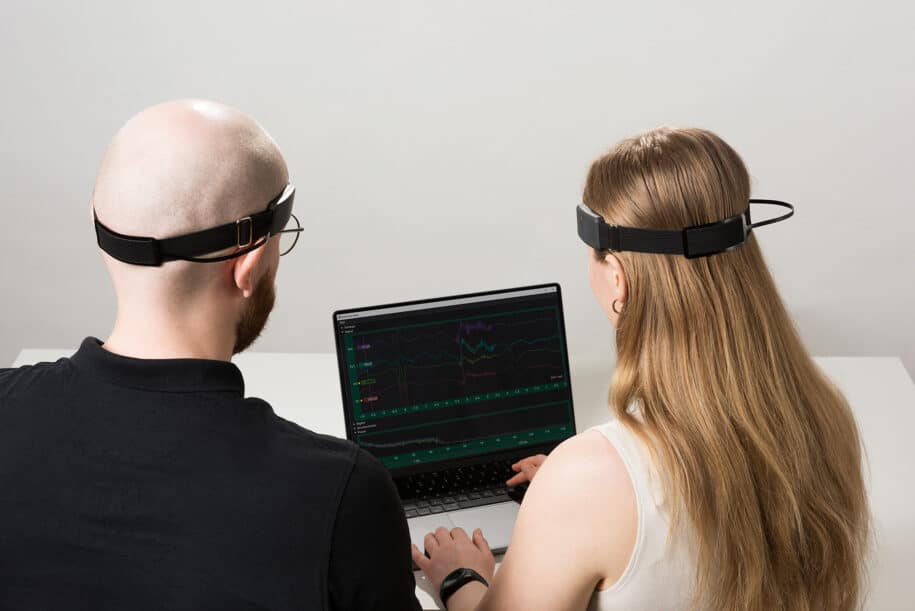Electroencephalography (EEG), a non-invasive neurophysiological technique, employs the measurement of cortical electrical activity via scalp electrodes. The efficiency of EEG recording is linked to the cap technology employed, which dictates electrode placement, signal quality and user comfort and experience. In this article, we will provide a comparative analysis of EEG cap technologies, ranging from simplified headbands to high-density multi-channel caps, highlighting their applications and characteristics.
EEG headbands for simplified data gathering
Consumer-grade EEG headbands represent a simplified approach to EEG data acquisition, prioritizing user accessibility and ease of application. Characterized by a limited number of electrodes, typically 2-4, these devices are designed for rapid deployment and minimal user training.
A prominent application example for EEG headbands is sleep monitoring. The simplified electrode configuration makes recording data domestic settings easier, enabling the characterization of sleep architecture and the detection of sleep-related physiological events.
According to A. B. Kent et al., a simplified EEG headband can be effectively used to monitor sleep patterns in patients with mild to moderate Alzheimer’s disease (AD) at home, revealing a significant reduction in slow-wave sleep compared to healthy controls. This method provides a feasible alternative to clinical polysomnography, enabling more accessible and comfortable sleep assessments for AD patients and facilitating future research into sleep-targeted therapies.
Headbands can also be applied for extensive research in groups. Hyperscanning, the simultaneous recording of brain activity from multiple individuals, is significantly enhanced by the use of headbands. The easy setup of these devices simplifies the research process, allowing for efficient data collection from numerous participants.
8-channel EEG caps
8-channel EEG caps offer an intermediate level of spatial resolution, providing a more refined representation of cortical activity compared to headbands. These caps are frequently employed in Brain-Computer Interface (BCI) research and development, where the balance between data richness and computational efficiency has to reach a high level. The flexibility in electrode placement that can be deployed in these caps enables targeted acquisition from specific cortical regions.
The cost-effectiveness of 8-channel EEG caps makes them suitable for educational and research environments with budgetary constraints. They can be a good choice for the exploration of BCI principles and the development of prototype applications.
32-channel EEG caps

32-channel EEG caps represent a standardized configuration widely adopted in cognitive neuroscience research. These caps provide a comprehensive coverage of the scalp, enabling the characterization of distributed cortical networks involved in complex cognitive processes. The consistent application of these configurations across research laboratories ensures that the data is compatible and provides the means for meta-analysis.
32-channel caps can be used to record brainwaves during physical exercises. For example, this study demonstrates that a 32-channel wireless EEG system provides highly repeatable brain activity measurements during moderate-intensity resistance exercise, suggesting its reliability for tracking brain function changes in longitudinal studies. The benefits of a 32-channel cap include its ability to capture scalp-wide brain activity with excellent reliability, facilitating the study of brain responses during physical tasks and the potential for use in therapeutic interventions.
While not classified as high-density, 32-channel EEG caps offer a substantial improvement in spatial resolution compared to lower-channel configurations. The increased number of electrodes enhances the accuracy of source localization algorithms. The relatively low cost of these caps contributes to their widespread adoption in academic research.
High-density EEG caps (60-1000+ channels)
High-density EEG caps, characterized by electrode counts exceeding 60, represent the state-of-the-art in EEG technology. These systems offer exceptional spatial resolution, enabling the detailed mapping of the scalp and the precise localization of neural generators. The application of high-density EEG is primarily confined to clinical research and specialized neuroimaging laboratories, because they require financial investment and computational resources.
This research on high-density caps introduces and validates a novel 256-channel high-density electroencephalography (HD-EEG) cap utilizing dry multipin electrodes, demonstrating its ability to significantly reduce preparation time and enable applications by non-medically trained personnel while maintaining comparable signal quality to traditional gel-based caps. The dry electrode cap achieved reliable EEG recordings with improved user comfort and durability. Meaning, that even high-channel count caps can be time-effective.
High-density EEG caps are particularly valuable in clinical settings, where precise localization of brain activity is crucial for diagnosis and treatment. They can be used to understand epilepsy patients, identify areas of brain damage after a stroke and study the various neurological disorders.
Choosing the right cap
The selection of an EEG cap depends on the specific application and budget. For simple applications like sleep monitoring, headbands offer a convenient and affordable solution. For BCI development and research, 8-channel and 32-channel caps provide a good balance between data quality and cost. High-density caps, while expensive, offer the highest spatial resolution and are an inseparable part of clinical research.
The analysis of high-density EEG data necessitates sophisticated signal processing techniques and advanced computational infrastructure. Researchers are actively developing algorithms for source localization, connectivity analysis, trying to provide new advancements for neuroscience. BrainAccess provides several convenient options that can be customized according to the clients needs. For more information, consult the hardware page.
Conclusion
The selection of an EEG cap is dependent on the specific application, the possible budget, and desired outcome or the comprehensiveness of the data.
Consumer-grade headbands offer a simplified approach for personal applications, while 8-channel and 32-channel caps provide a broader data scope and convenience for BCI development and cognitive neuroscience research.
High-density EEG caps are especially significant for clinical research and specialized analysis of various illnesses, enabling a deeper investigation of the dynamics of the human brain.
As EEG technology continues to evolve, the development of cost-effective and user-friendly software and hardware will enable broader applications and even more comprehensive results.
Sources
Kent, B. A., Casciola, A. A., Carlucci, S. K., Chen, M., Stager, S., Mirian, M. S., Slack, P., Valerio, J., McKeown, M. J., Feldman, H. H., & Nygaard, H. B. (2022b). Home EEG sleep assessment shows reduced slow‐wave sleep in mild–moderate Alzheimer’s disease. Alzheimer S & Dementia Translational Research & Clinical Interventions, 8(1). https://doi.org/10.1002/trc2.12347
Fiedler, P., Fonseca, C., Supriyanto, E., Zanow, F., & Haueisen, J. (2021). A high‐density 256‐channel cap for dry electroencephalography. Human Brain Mapping, 43(4), 1295–1308. https://doi.org/10.1002/hbm.25721
Domingos, C., Marôco, J. L., Miranda, M., Silva, C., Melo, X., & Borrego, C. (2023). Repeatability of Brain Activity as Measured by a 32-Channel EEG System during Resistance Exercise in Healthy Young Adults. International Journal of Environmental Research and Public Health, 20(3), 1992. https://doi.org/10.3390/ijerph20031992

